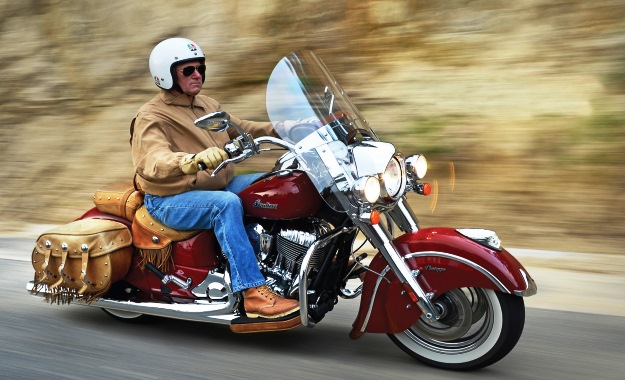
Indian, one of the most revered names in classic American motorcycling, has finally been properly revived. We say properly because this time, the brand’s owner is Polaris, which manufactures snowmobiles, quads and Victory bikes. It’s somewhat expected that Indian would utilise Victory powerplants, but the newcomer’s engines are built specifically at a plant in Spirit Lake, Iowa.
The three models in the range are the Chief Classic, the Chief Vintage and the Chieftain. There are no prizes for guessing that our test unit was the Vintage; with lots of tan cowhide covering the seat, backrest, panniers and the tips of the swooping mudguards, this bike really stands out. The panniers have old-school buckle straps, but behind them are side-release snap buckles. Still, there are three panniers a-side, which are somewhat fiddly to access. An optional dash-top bag is handy for quick stowage of keys or shades. Whereas the leather kit is also available in black, colour options for the bodywork are Indian Motorcycle Red, Springfield Blue (the first factory was founded in Springfield, Massachusetts, in the 1900s) and Thunder Black. There is a very retro light-greenand- cream colour scheme that might make its way to the local market next year.
The design team wanted to retain traditional cues such as the air-cooled, inline V-twin configuration, but had to forego the old side-valve layout due to cooling problems and opted for a pushrods-with-overhead-valves configuration. A 49-degree cylinder configuration with finned rocker covers and triple camshafts complete the design.
The central camshaft operates each cylinder’s single inlet valve, while gears drive the other two that control the exhaust valves with parallel pushrods. The engine capacity is 111 cubic inches and so the engine is called the “Thunder Stroke 111”. The motor has a longer stroke than bore, giving it a high torque output of 139 N.m. True to the cruiser norm, the power is not a subject important enough to discuss. Dual exhausts (optional aftermarket stage-one setup) are long, very throaty and
adorned with multiple fluting at the outlets.
There are a few nods to modernity such as Bosch fuel injection, hydraulic tappets and a six-speed gearbox. In keeping with the Indian’s all-American tradition, the lone dial mounted on the tank houses only a speedometer. But Indian has nevertheless embraced the digital age by adding a trip computer that displays dual trip odos, ambient temperature, fuel consumption, range to empty, low fuel indicator, gear indicator and a rev counter. And for highway trips, cruise control is fitted. Braking uses twin discs up front, one at the rear, and ABS. The massive mudguards and panniers almost hide the single rear shock, drive belt and white-sidewall tyres.
During our limited test period, we returned a fuel consumption figure of 7,76 litres/ 100 km, which means that the Indian’s tank range is not great. Still, on the 20,8-litre capacity you should get over 250 km. The engine design proves its worth by the Vintage’s ability to trundle smoothly at 1 200 r/min right up to when it runs out of steam at 5 600 r/min. The other impressive aspect is the lack of unpleasant vibration; as for the lumpy thumps of V-twin and the (quite loud) off-beat exhaust note … well, they’re all part of the Indian’s appeal.
As soon as you hit the highway, this machine evokes thoughts of spearing down the fabled Route 66 – or Route 62 or the Long Tom Pass, for that matter. It loves barrelling along and absolute speed doesn’t really matter to the rider; it’s equally happy at 100 or 150 km/h. There is no degree of wind interference/buffeting that bears a mention. The large screen channels the air skywards and creates a partial vacuum behind the glass, making it easy to open your visor at cruising speeds.
What’s more, the ride quality is superbly pliant. Yes, there is some dive accompanied by fore-to-aft rocking when stopping briskly, but this doesn’t seem to be detrimental to handling, remembering that the point of the Chief is to cruise and not
to scrape your kneepads. The kerb mass of our test bike was 392 kg, which is about 13 kg more than a standard bike’s. Seat height is low and the footboards give you some leeway for resting your boots. Gear changes from the six-speed ‘box are clunky, as we expected, but can be improved if you leave the clutch untouched.
TEST SUMMARY
There’s no doubt that the Indian is a well-executed reimagining of an American classic. The nearest equivalent Harley-Davidson is the Road King Classic, which has similar characteristics, but a smaller 103 engine and costs R272 000, which is significantly cheaper. But then there is the CVO Road King with the 110 engine (one cubic-inch less than the Indian). That version costs R355 000 – unsurprisingly, the same as the Chief Vintage. If it’s a burbly old-school cruiser you’re after, you’re spoilt for choice.




